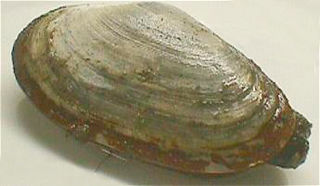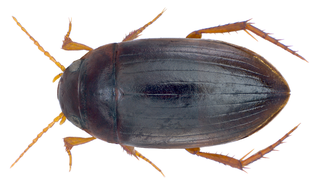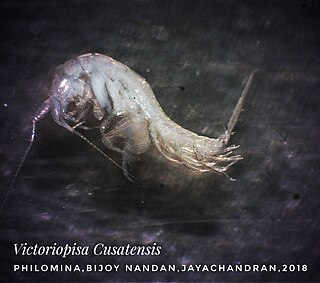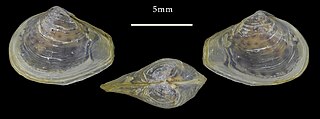
The Boridae are a small family of tenebrionoid beetles with no vernacular common name, though recent authors have coined the name conifer bark beetles. The family contains three genera. Boros is native to North America and northern Eurasia, Lecontia is endemic to North America, while Synercticus is found in Australia and New Guinea. The larvae of Boros are found under bark and are especially associated with standing dead trees (snags), typically pines, found in old-growth forests. Lecontia larvae are found inhabiting damp parts of the root system of dead standing trees. Little is known of the life habits of Synercticus.

The Eupnoi are a suborder of harvestmen, with more than 200 genera, and about 1,700 described species.

Myidae, common name the softshell clams, is a taxonomic family of marine bivalve molluscs in the order Myida.

Hyles livornica, the striped hawk-moth, is a moth of the family Sphingidae.

Chaetosomatidae is a small family of beetles, in the superfamily Cleroidea. There are three extant genera, two of which are endemic to New Zealand with the other (Malgassochaetus) native to Madagascar. Members of this family are predaceous on wood-boring insects.

Phycosecidae is a family of beetles in the superfamily Cleroidea., containing the single genus Phycosecis found in Australia, New Caledonia, New Zealand and Vanuatu. The beetles are small, about 1.5–3.5 mm in length. They live in sandy coastal areas, and are saprophagous, feeding on faeces, carrion, and dead arthropods during the daytime.

Zebina is a genus of minute sea snails, marine gastropod mollusks or micromollusks in the family Zebinidae.

Raphitomidae is a family of small to medium-sized sea snails, marine gastropod mollusks in the superfamily Conoidea.
Copelatus abonnenci is a species of diving beetle. It is part of the genus Copelatus of the subfamily Copelatinae in the family Dytiscidae. It was described by Guignot in 1939.

Copelatus glyphicus is a species of diving beetle. It is part of the genus Copelatus in the subfamily Copelatinae of the family Dytiscidae. It was described by Say in 1823.
Copelatus louayensis is a species of diving beetle. It is part of the genus Copelatus in the subfamily Copelatinae of the family Dytiscidae. It was described by Bilardo & Rocchi in 2004.
Copelatus masculinus is a species of diving beetle. It is part of the genus Copelatus, which is in the subfamily Copelatinae of the family Dytiscidae. It was described by Régimbart in 1899.

Copelatus tenebrosus is a species of diving beetle. It is part of the genus Copelatus in the subfamily Copelatinae of the family Dytiscidae. It was described by Régimbart in 1880.

Acteocina is a genus of very small sea snails, bubble snails, marine opisthobranch gastropod mollusks in the family Tornatinidae, the canoe bubbles or chalice bubble snails.

Potamocorbula is a genus of very small saltwater clams, marine bivalve molluscs in the subfamily Erodoninae of the family Corbulidae in the order Myida.
Stygarctus is a genus of tardigrades in the family Stygarctidae. It was named by Erich Schulz in 1951. The name is a combination of Greek Styx and arktos ("bear").

Nassodonta insignis is a species of brackish water snail, with gills and an operculum, a gastropod mollusk in the family Nassariidae.

Victoriopisa cusatensis is a amphipod species in the family Eriopisidae. The species name ‘cusatensis’ refers to the Cochin University of Science and Technology (CUSAT). This species has been described by the team of researchers in 2018 from the Valanthakad mangrove area of Vembanad backwater.

Indosphenia kayalum is a small bivalve species inhabiting fragmented brackish-water habitats around Kochi backwater, Kerala. The specific name kayalum is derived from kayal, the Malayalam name for these backwaters. This species was described in 2018 from the Ezhupunna region of Cochin Backwater, Vembanad Lake along with other myid clam Mytilopsis and brackish water gastropod Nassodonta insignis. This is the fifth species described in the genus Indosphenia. The other species recognized under this genus are Indosphenia cochinensis, Indosphenia abbreviata, Indosphenia abbreviata chilkaensis and Indosphenia sowerbyi.
Macrobrachium indicum is a species of freshwater shrimp of South India. It was first described in 1986. This freshwater prawn was described from Vellayani Lake, Kerala. This species is closely related to M. australe and M. ustulatum. It is a medium-sized prawn of genus Macrobrachium.















